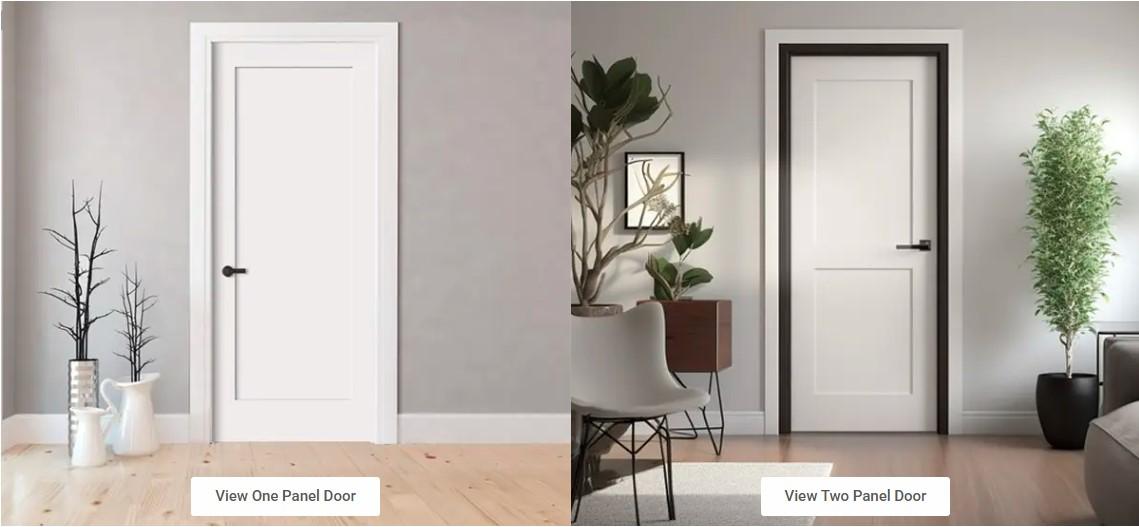When it comes to choosing interior doors for your home, solid core doors are a popular and practical option. They offer a balance between durability, sound insulation, and aesthetics, making them an excellent choice for bedrooms, offices, and high-traffic areas.
In this comprehensive guide, we’ll explore everything you need to know about solid core interior doors, including their benefits, materials, installation, maintenance, and how they compare to other types of doors.
What Are Solid Core Interior Doors?
Solid core interior doors are constructed with a dense, solid inner core—often made of wood composite, particleboard, or fiberglass—covered with a veneer or laminate finish. Unlike hollow core doors, which have an empty interior, solid core doors provide better soundproofing, stability, and durability.
Key Features of Solid Core Doors:
-
Heavier and sturdier than hollow core doors
-
Better sound insulation due to dense core material
-
More resistant to dents and damage
-
Available in various finishes (wood veneer, laminate, painted)
-
Suitable for high-traffic areas
Benefits of Solid Core Interior Doors
1. Superior Soundproofing
One of the biggest advantages of solid core doors is their ability to reduce noise transfer between rooms. The dense core material absorbs sound, making them ideal for:
-
Bedrooms (for privacy and quiet)
-
Home offices (to minimize distractions)
-
Media rooms (to contain sound)
While they don’t provide the same level of soundproofing as solid wood doors, they are significantly better than hollow core doors.
2. Enhanced Durability
Solid core doors are more resistant to warping, dents, and scratches compared to hollow core doors. This makes them a great choice for:
-
High-traffic areas (hallways, kids’ rooms)
-
Commercial spaces (offices, hotels)
-
Homes with pets (less prone to damage from claws)
3. Better Insulation
The dense core helps with temperature regulation, making rooms more energy-efficient by reducing drafts.
4. Aesthetic Appeal
Solid core doors come in various finishes, including:
-
Wood veneers (oak, mahogany, maple)
-
Painted finishes (custom colors to match décor)
-
Modern laminates (sleek, contemporary look)
They can mimic the appearance of solid wood doors at a lower cost.
5. Increased Home Value
Because of their durability and premium feel, solid core doors can enhance the overall value of your home.
Solid Core vs. Hollow Core vs. Solid Wood Doors
| Feature | Solid Core Doors | Hollow Core Doors | Solid Wood Doors |
|---|---|---|---|
| Material | Composite core with veneer | Hollow interior with thin veneer | 100% solid wood |
| Weight | Heavy | Light | Very heavy |
| Soundproofing | Good | Poor | Excellent |
| Durability | High | Low | Very high |
| Cost | Moderate | Affordable | Expensive |
| Best For | Bedrooms, offices, high-traffic areas | Closets, low-use areas | Luxury homes, high-end interiors |
When to Choose Solid Core Doors?
-
You want better sound insulation without the high cost of solid wood.
-
You need durable doors for busy households.
-
You prefer a premium look without the maintenance of real wood.
Materials Used in Solid Core Doors
1. Wood Composite Core
-
Made from compressed wood fibers and resin
-
Offers good stability and moisture resistance
-
Common in mid-range solid core doors
2. Particleboard Core
-
Made from wood chips and adhesive
-
More affordable but less moisture-resistant
-
Best for dry indoor environments
3. MDF (Medium-Density Fiberboard) Core
-
Smooth, uniform surface for painting
-
Good soundproofing but can swell in humidity
4. Fiberglass-Reinforced Core
-
Highly durable and moisture-resistant
-
Ideal for bathrooms or humid climates
Installation Tips for Solid Core Doors
Since solid core doors are heavier than hollow core doors, proper installation is crucial.
Steps for Installation:
-
Measure Accurately – Ensure the door fits the frame with proper clearance.
-
Use Heavy-Duty Hinges – At least three hinges for stability.
-
Reinforce the Door Frame – Prevents sagging over time.
-
Check for Level and Plumb – Ensures smooth operation.
-
Consider Professional Help – If unsure, hire a carpenter for precise fitting.
Maintenance and Care
-
Cleaning – Wipe with a damp cloth; avoid harsh chemicals.
-
Painting/Refinishing – Can be repainted or re-stained if needed.
-
Hardware Checks – Tighten hinges and knobs periodically.
-
Moisture Protection – Avoid excessive humidity to prevent warping.
Cost of Solid Core Interior Doors
Prices vary depending on material, finish, and brand:
-
Basic models: 150–150–300 per door
-
Premium finishes: 300–300–600+ per door
-
Custom sizes/styles: Higher cost
While more expensive than hollow core doors, they offer better long-term value.
Conclusion
Solid core interior doors are an excellent investment for homeowners seeking durability, noise reduction, and a high-end look without the cost of solid wood. Whether you're renovating or building a new home, they provide the perfect balance of functionality and style.
If you're looking for doors that last, improve privacy, and enhance your home’s aesthetic, solid core doors are a smart choice.
Ready to upgrade your interior doors? Explore different styles and finishes to find the perfect match for your home!

